If you’re into nature, you may also be into skulls. And if you’re into skulls, you’ve probably struggled with skull processing. To do it right you need a terrarium and some dermestid beetles, but that costs time and money. (One website is selling a colony that’ll clean your skulls in 3 – 4 weeks for $230, plus shipping and handling.) Depending on your spouse’s level of squeamishness, bringing flesh eating beetles into your basement may also cost you your marriage.
I’ve always processed skulls on the cheap, and while I’m no expert, I can offer a few probably-helpful tips to those new to the craft. If nothing else, I may save you a mistake or two.
When I was a kid I used to skin the skulls and then boil them, but I was never really happy with this method. I’d boil for hours before the flesh would loosen, and even then, I’d have grizzled bits that stuck like glue. It smelled; it seemed to shrink the skulls; it ruined pots. (If you’re thinking: oh, his poor mother, you should know that my elementary-school-teacher mom was the one who got me into this macabre craft in the first place.)
What I do now is simply put the skull, hair and all, into an oversized Havahart trap that’s wired securely to a post so no animal can drag it away. There’s a mesh tray with a layer of window screen under the skulls to hold the bones. And then I just let nature do the hard work for me. I throw some composted horse manure on top of the skulls, which seems to keep odor down. I also suspect it encourages microbes and beetles while discouraging maggots, which may not matter at all in the grand scheme of things – this is just how I do it. In a month or two, I come back and the skulls are largely clean. I’m always surprised by how little stink there is.
This method works best with big skulls. The smaller things get, the finer the bones and teeth, the more problems you’re going to have. Mice can be a particular problem, as they have a habit of walking off with skull parts if you leave enough space for them to do so. My general rule is that big skulls – deer, bear, beaver – can go in as is. With mid-sized skulls (fox, raccoon, etc.), I skin them and put a zip tie around the jaw to hold them together. This pays great dividends as it often keeps all the teeth intact in the jaw bone. With skulls smaller than that, I take pains to wrap the skull so it falls apart in a more controlled, contained way. As I said, small skulls are tough.
After nature’s taken the hair and meat off the skulls, it’s just a matter of cleaning them up. I use soapy warm water and a toothbrush to get them clean. They then go in a hydrogen peroxide bath. I’ve used bleach before and it does a fine job, but I’ve been told by reputable-seeming people that bleach degrades the bone and that peroxide is a much better way to go. In the pictures below you’ll see I’m using an old drawer and had to flip the skulls half way through. It would have been better to use a shallow tub where the skulls could be submerged completely, I just didn’t have one at hand.
I like a yellowy, natural-looking finish – bright white skulls seem fake-looking to me, like they’re made out of plastic – so I’m fine using the 3% peroxide you buy in the drug store for less than $1 a quart. You’ll need to leave the skulls in to soak for a week or so. You can buy more concentrated peroxide – 12 percent and 35 percent are two stronger options that are commonly available – which will give you a whiter and more uniform finish and will decrease your soak time. But I don’t know if you can overdo it with these concentrations, so be careful. And, of course, the more concentrated the more caustic, so be careful there, too.
Hopefully this is helpful to somebody. If I left anything out, or if someone has another tip to share, by all means chime in.


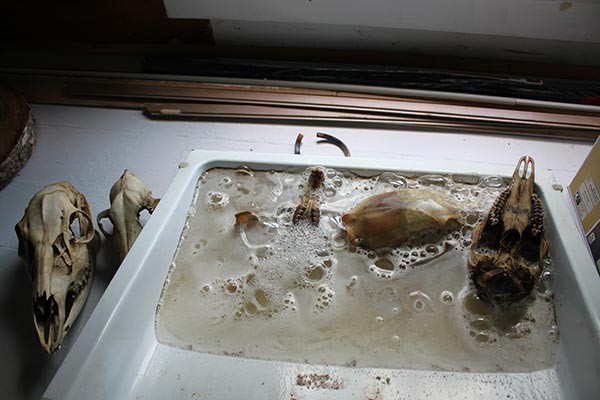
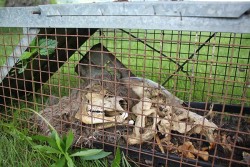
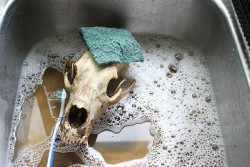
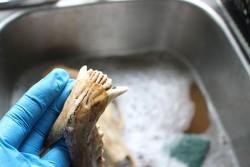
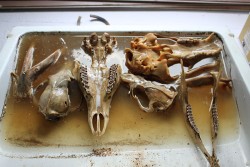
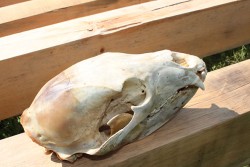
Discussion *